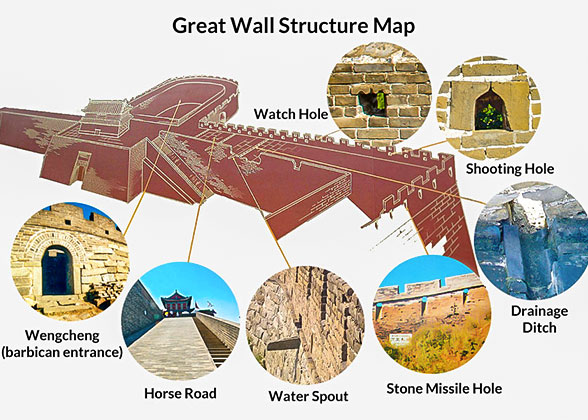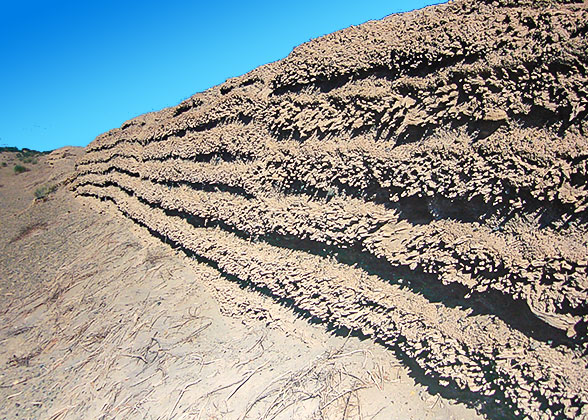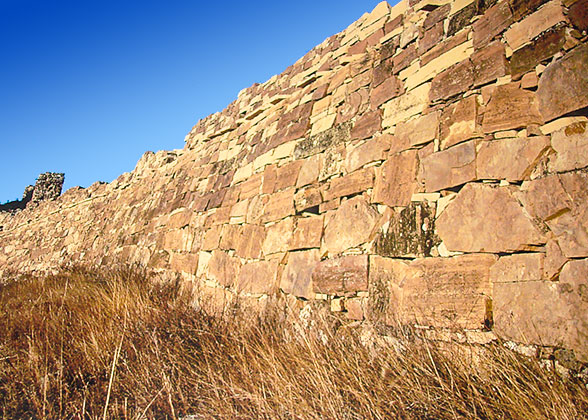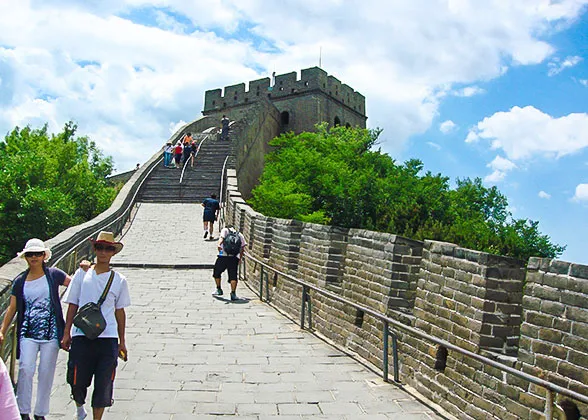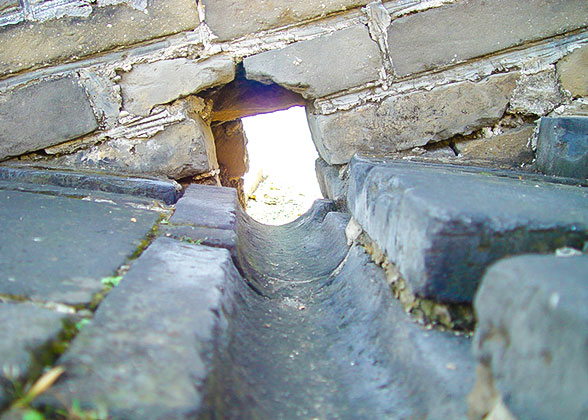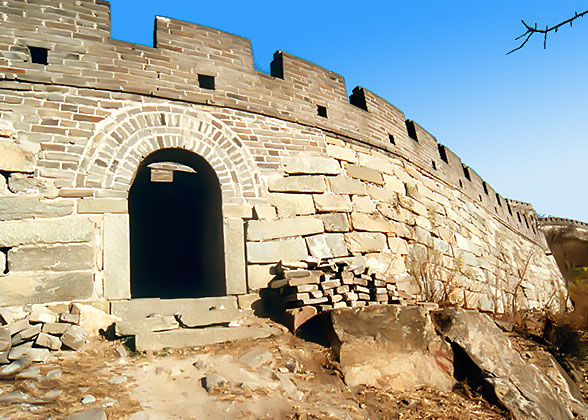copy from :http://www.travelchinaguide.com
The Great Wall, one of the greatest wonders of the world, was listed as a World Heritage by UNESCO in 1987. Just like a gigantic dragon, the Great Wall winds up and down across deserts, grasslands, mountains and plateaus, stretching approximately 8,851.8 kilometers (5,500 miles) from east to west of China. With a history of more than 2000 years, some of the sections are now in ruins or have disappeared. However, it is still one of the most appealing attractions all around the world owing to its architectural grandeur and historical significance.
Chinese Name: 长城/万里长城
Chinese Pinyin: Cháng Chéng/Wàn Lǐ Cháng Chéng
Length: 8,851.8 km (5,500 miles)
Construction Period: About 2,000 years from the Warring States Period (476 BC - 221 BC) to Ming Dynasty (1368-1644)
The Wall we see today was mostly built during the Ming Dynasty (1368 - 1644). It starts from Hushan in the east to Jiayuguan Pass in the west traversing Liaoning, Hebei, Beijing, Tianjin, Shanxi, Inner Mongolia, Ningxia, Shaanxi, Gansu and Qinghai. Here lists the famous sections for you to know the incredible diversity of scenery along the wall and practical travel tips.
Excitement abounds regarding the vicissitude of the Wall of the Qin, Han, and Ming Dynasties.
The Great Wall was originally built in the Spring and Autumn, and Warring States Periods as a strong Security system by the three states: Yan, Zhao and Qin. It went through constant extensions and repairs in later dynasties. It began as independent walls for different states when it was first built, and did not become the "Great" wall until the Qin Dynasty. Emperor Qin Shihuang succeeded in his effort to have the walls joined together to fend off the invasions from the Huns in the north. Since then, the Wall has served as a monument of the Chinese nation throughout history.
|
| ||
| Great Wall Structure Illustration |
In the Qin Dynasty (221 - 206 BC) the emperor Qin Shihuang ordered his laborers to connect these scattered walls and create some new sections, thus forming a Great Wall in northern and central China in the true sense. The Ming Dynasty (1368 - 1644) further developed the defensive system of the wall and strengthened it on a larger scale. It pushed the wall construction to its highest peak.
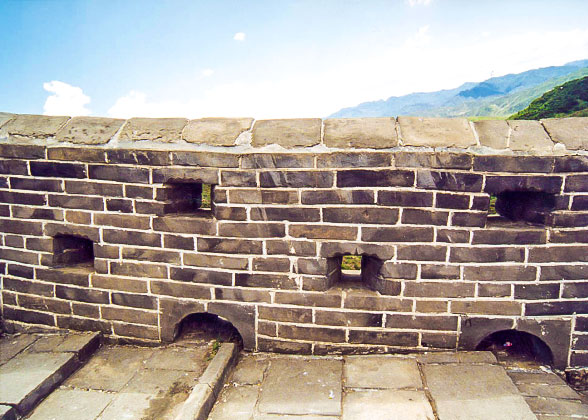 |
| Battlement Wall with Loopholes |
The average height of the Ming Great Wall measures 33 feet and the width is about five yards. In low, flat areas the wall was built high and more defense lines were added. In the lofty mountains, the wall was a little lower in order to save the human and financial cost. Sometimes, even steep cliffs served as natural walls to thwart enemies.
Today, the Great Wall has lost its military function, but as a great ancient engineering work, its magnificent beauty and austere structure are still worthy appreciating.
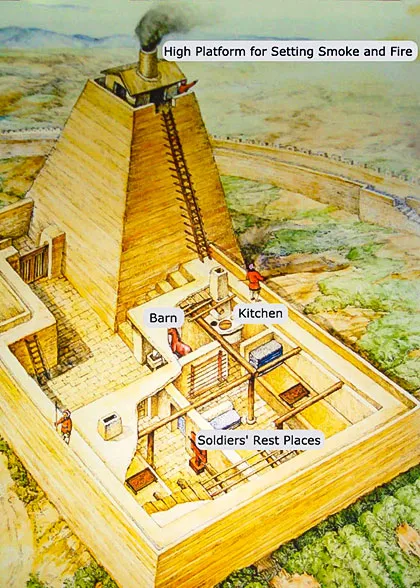 |
| Internal Structure of Beacon Tower |
Constructional Structure:The history of the beacon tower construction is earlier than the building of the Great Wall. Han Dynasty (206BC – 220AD) emphasized on the construction of beacon towers, in some sections, the successive towers even replaced the wall to form the defense system. As per the construction of the wall, they were built by using local materials according to the local conditions. In mountainous areas, they are built by laying pieces of stones and bricks. While in grassland and desert, they are of rammed-loam construction. The shape differ and are square, rectangular or round.
Constructional Type:There are mainly three types of Great Wall beacon towers. The first type is built on the wall. It is the fastest to pass military messages. If enemies came, soldiers would be maneuvered in shortest time and got ready to quickly fight. The second type is the one located inside the wall and connects the passes or garrisons. In early times, some towers even directly linked to the capital, for the convenience of alerting the court. The third is built some distance away from the wall, to watch the enemies' movements.
Defense System:
Defense System:
 |
| Beacon Tower in Ming Dynasty |
King You was the last King of the Western Zhou Dynasty (11th century BC - 771 BC). He was a foolish and self-indulgent ruler. Baosi, the beautiful concubine whom he loved, was very solemn and never cracked a smile. King You asked people in and out of court for ideas to make her smile. However, none of their suggestions worked and the beauty still looked unhappy.
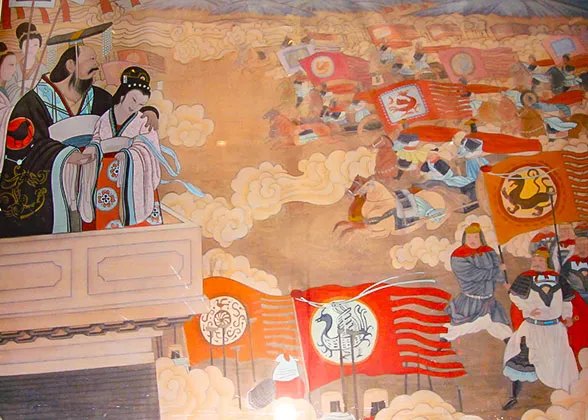 A court official named Guo Shifu then suggested that the King light the beacon towers all on Mt. Lishan. The towers had been used as warning signals against enemy attacks and to summon help. Fires or lanterns were used at night and smoke signals during the day. He assured the King that Baosi would smile when she saw that so many soldiers were fooled. The King agreed to try this plan. He took Baosi to Mt. Lishan, ordered his men to light the beacon towers and waited. When nearby rulers saw the flames in the sky, they thought the King was in danger and dispatched soldiers to his aid. King You then told them that it was only a joke. On seeing the disappointed soldiers scrambling to leave, Baosi burst into a smile. This made the king very happy. He rewarded Guo Shifu generously. The joke was repeated more than once.
A court official named Guo Shifu then suggested that the King light the beacon towers all on Mt. Lishan. The towers had been used as warning signals against enemy attacks and to summon help. Fires or lanterns were used at night and smoke signals during the day. He assured the King that Baosi would smile when she saw that so many soldiers were fooled. The King agreed to try this plan. He took Baosi to Mt. Lishan, ordered his men to light the beacon towers and waited. When nearby rulers saw the flames in the sky, they thought the King was in danger and dispatched soldiers to his aid. King You then told them that it was only a joke. On seeing the disappointed soldiers scrambling to leave, Baosi burst into a smile. This made the king very happy. He rewarded Guo Shifu generously. The joke was repeated more than once.
But as a Chinese saying goes, "sadness usually follows extreme happiness." In 771 BC, the northern tribe of Quan Rong invaded his country. The King, as usual, commanded his soldiers to light the towers, but by this time the other rulers had wised up and ignored his call for help. The king was killed and his beauty captured. The Western Zhou Dynasty collapsed and hence the legend of Great Wall beacon tower spread.
he bodies of the wall, linking beacon towers, watch towers, and passes into a defensive line, are the main part of the Great Wall. Their heights differ depending on the local terrain. In flat areas and places of military importance, it is built quite high. While in the steep mountains and places of less important military meaning, it is built comparably lower to save financial and human resources. Generally speaking, the wall measures about 23 to 26 feet tall. The fracture surface of the wall is ladder type with the base measuring about 7.1 yards wide and the top measuring 6.3 yards wide on average, which makes it firm and very unlikely to collapse.
Constructional Materials & Methods
The Great Wall of China was built using local materials and in a manner according to the technological level of the periods. Construction was mainly rammed-earth, bricks, and stone walls. Rammed-earth wall was the earliest method of wall construction. Before the Sui Dynasty (581 - 618), workers always adopted this way. They first filled a wooden mold with clay or plaster, then compressed it by pestle until it was hardened into shape, and finally laid them piece by piece to the satisfactory height and length. In desert terrain where suitable earth was not available, sand mixed with debris and willow branch was used as a replacement. This kind is much easier to build but also easy to be destroyed by enemies and susceptible to collapsing after long periods of time.
Brick walls became popular during the Tang Dynasty (618 - 907) when the technique of brick production was fully developed. However, bricks were expensive at that time which limited its use in the construction of city gates and nearby walls. The outsides of walls were built by laying pieces of bricks while the inner walls were filled with yellow earth. Due to the increase of production levels of bricks in the Ming Dynasty (1368 - 1644), the cheap but high quality bricks were largely used. The wall was made strong enough to not only stop the intruders' steps, but also was able to resist attack from newly-invented firearms of the period. Of course, bricks must be agglutinated one by one to make the wall strong. During the Ming Dynasty, workers used lime mortar mixed with sticky rice juice as cementation materials which proved to be a very effective method.
|
|
Attached Designs
There are many necessary designs attached to China Great Wall to make the defense system complete.
|
|
|
|
